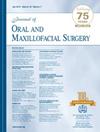Does Postoperative Disc Position Following Double Suture Arthroscopic Discopexy Correlate With Improvements in Pain and Quality of Life?
IF 2.3
3区 医学
Q2 DENTISTRY, ORAL SURGERY & MEDICINE
引用次数: 0
Abstract
Background
Temporomandibular joint intra-articular pain and dysfunction (IPD) can arise from abnormal disc position. Arthroscopic double-suture discopexy (A-DSD) aims to restore disc position, but the association between disc position and patient-reported pain and quality of life (QoL) is unclear.
Purpose
This study investigated the relationship between postoperative disc position and subject QoL and pain following A-DSD.
Study Design, Setting, Sample
This retrospective cohort study included subjects at the University of Michigan who required arthroscopy for IPD between November 2020 and July 2023. Eligibility included subjects aged ≥18 to 75 years with Wilkes II-V IPD who underwent A-DSD with preoperative and postoperative magnetic resonance imagings (3 months minimum).
Predictor Variable
The predictor variable was postoperative magnetic resonance imaging–based disc position: normal (ND), anteriorly displaced with reduction (ADDwR), anteriorly displaced without reduction (ADDwoR), or posteriorly displaced.
Main Outcome Variable(s)
Main outcomes are changes in QoL (Jaw Functional Limitation Scale [JFLS]) and pain (visual analog scale-100) at baseline and ≥3 months post-arthroscopy.
Covariates
Covariates included demographics, perioperative variables, and arthroscopic findings.
Analyses
Paired t-tests evaluated changes in perioperative outcomes stratified by postoperative disc position. For analysis of covariates and outcomes, linear regression was applied for JFLS (subject-level analysis); linear mixed-effects models, adjusting for nonindependent observations for bilateral cases, were used for pain (joint-level analysis). Statistical significance was P < .05.
Results
A total of 240 subjects were screened and 37 were included with mean age 33 (±14.3) years and all were female sex (100%). Median follow-up was 9 months (interquartile range, 8 to 12). Postoperative disc positions were ND (70.2%), ADDwR (15.8%), ADDwoR (8.8%), and posteriorly displaced (5.3%). Postoperative disc position was associated with JFLS (P = .026) and pain (P = .0002), with worse outcomes for ADDwR. ND subjects experienced significant decreases in JFLS (36.3 ± 34.6, P < .0001) and pain (28.7 ± 27.8, P < .0001). ADDwoR subjects showed significant reduction in JFLS (47.1 ± 32.0, P = .03), but not pain. ADDwR subjects showed no significant outcome improvements. Subjects with systemic arthropathies (P = .01), closed lock (P = .03), and indirect trauma (P = .03) were associated with worse JFLS.
Conclusions and Relevance
Postoperative ND and ADDwoR after A-DSD were associated with improved QoL and/or pain reduction, but postoperative ADDwR and the above comorbidities were associated with poorer outcomes.
双缝线关节镜下椎间盘移位术后椎间盘位置与疼痛和生活质量的改善相关吗?
背景:颞下颌关节关节内疼痛和功能障碍(IPD)可由异常的椎间盘位置引起。关节镜下双缝线discopixy (A-DSD)旨在恢复椎间盘位置,但椎间盘位置与患者报告的疼痛和生活质量(QoL)之间的关系尚不清楚。目的:探讨A-DSD术后椎间盘位置与受试者生活质量和疼痛的关系。研究设计、环境、样本:这项回顾性队列研究包括密歇根大学在2020年11月至2023年7月期间因IPD需要关节镜检查的受试者。受试者年龄≥18 - 75岁,患有Wilkes II-V型IPD,术前和术后进行磁共振成像(至少3个月)进行A-DSD。预测变量:预测变量为术后基于磁共振成像的椎间盘位置:正常(ND)、前移位复位(ADDwR)、前移位不复位(ADDwoR)或后移位。主要结局变量:主要结局是基线和术后≥3个月时生活质量(颌功能限制量表[JFLS])和疼痛(视觉模拟量表-100)的变化。协变量:协变量包括人口统计学、围手术期变量和关节镜检查结果。分析:配对t检验评估术后椎间盘位置分层围手术期结果的变化。协变量和结果分析采用线性回归进行JFLS(受试者水平分析);线性混合效应模型,调整双侧病例的非独立观察,用于疼痛(关节水平分析)。结果:共筛选受试者240例,纳入37例,平均年龄33(±14.3)岁,均为女性(100%)。中位随访为9个月(四分位数范围为8至12)。术后椎间盘位置为ND(70.2%)、ADDwR(15.8%)、ADDwoR(8.8%)和后移位(5.3%)。术后椎间盘位置与JFLS (P = 0.026)和疼痛(P = 0.0002)相关,ADDwR的预后更差。ND患者JFLS显著降低(36.3±34.6,P)。结论及相关性:A-DSD术后ND和ADDwoR与生活质量改善和疼痛减轻相关,但术后ADDwR和上述合并症与预后较差相关。
本文章由计算机程序翻译,如有差异,请以英文原文为准。
求助全文
约1分钟内获得全文
求助全文
来源期刊

Journal of Oral and Maxillofacial Surgery
医学-牙科与口腔外科
CiteScore
4.00
自引率
5.30%
发文量
0
审稿时长
41 days
期刊介绍:
This monthly journal offers comprehensive coverage of new techniques, important developments and innovative ideas in oral and maxillofacial surgery. Practice-applicable articles help develop the methods used to handle dentoalveolar surgery, facial injuries and deformities, TMJ disorders, oral cancer, jaw reconstruction, anesthesia and analgesia. The journal also includes specifics on new instruments and diagnostic equipment and modern therapeutic drugs and devices. Journal of Oral and Maxillofacial Surgery is recommended for first or priority subscription by the Dental Section of the Medical Library Association.
 求助内容:
求助内容: 应助结果提醒方式:
应助结果提醒方式:


